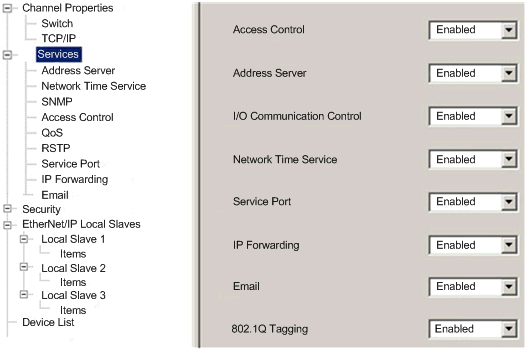|
Enabling Services
|
|
|
|

|
Step
|
Action
|
|---|---|
|
1
|
Double-click the 140NOC78100 head module in the DTM browser or right-click the module and click Open.
|
|
2
|
Click Services in the navigation tree located in the left panel of the Device Editor.
|
|
3
|
For each feature, change the setting as desired. Address Server, I/O Communication Control, and Service Port are Enabled by default. All other features are Disabled by default.
|
|
4
|
Click Apply to save changes, or click OK to save changes and close the window.
|
|
If this service is enabled...
|
The module can...
|
|---|---|
|
Access Control
|
Deny access to the 140NOC78100 head module by unauthorized network devices
|
|
Address Server
|
Provide both IP addressing parameters and operating parameters to other Ethernet devices
|
|
I/O Communication Control
|
Allow the Control Expert application to control the enabling and disabling of individual connections between the head module and remote I/O devices
NOTE:
|
|
Network Time Service
|
Synchronize computer clocks over the Internet for the purposes of event recording (sequence events), event synchronization (trigger simultaneous events), or alarm and I/O synchronization (time stamp alarms)
|
|
Service Port
|
Supports 3 functions:
|
|
IP Forwarding
|
Exchange network transparent data between the control network, the device network, and extended distributed I/O networks, while preserving remote I/O device network determinism
|
|
Email
|
Send email messages that notify you of custom events during application execution. Custom email messages are delivered to a preconfigured destination on demand by your application code.
|
|
SNMP
|
NOTE: The SNMP service is enabled. |
|
QoS Tagging
|
Network switches can prioritize the transmission and forwarding of Ethernet packets
NOTE: The QoS service is enabled. |
|
RSTP
|
Create a logical network path for Ethernet devices that are part of a topology that includes redundant physical paths. The RSTP-enabled module also automatically restores network communication — by activating redundant links — in the event the network experiences a loss of service.
NOTE: The RSTP service is enabled. |